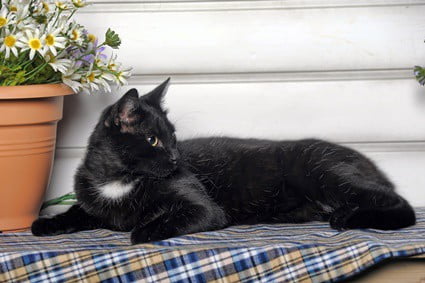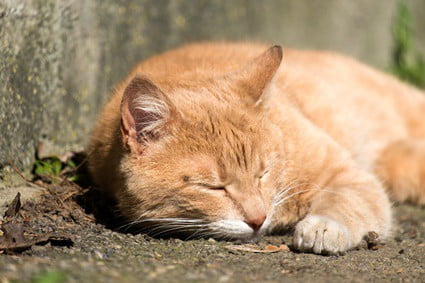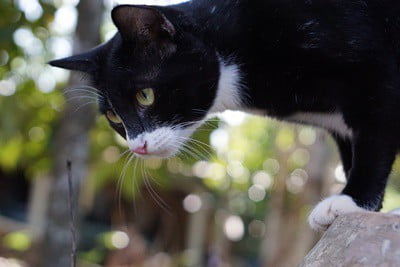Some cats have visible balding around the eyes, while others have thinning fur above the eyes.
Hair loss above a cat’s eyes (facial alopecia) occurs as cats grow in size and their fur thins out. Also, feline hair loss can be genetic or due to fungal infections, mites, fleas, and stress.
Facial hair loss in cats is usually a part of the aging process. As a cat grows, the same amount of hair on its body spreads out, causing the hair to thin in some areas. However, there are other explanations.
Why Are Cats Bald Above Their Eyes?
We’ll look at why cats lose fur over their eyes. If you notice any excessive itchiness, lesions on the skin, or redness, your cat likely needs treatment for a medical condition.
Facial Alopecia
Facial alopecia or preauricular alopecia (before the ear region) is a normal part of aging. It usually occurs on the head, above the eyes, and between the eyes and ears.
Hair thinning is neither a medical disorder nor a disease. Facial alopecia is most prominent in shorthaired cats with dark fur once they reach 1 or 2.
Kittens have the same hair density all over their bodies. As they grow, certain regions may appear to thin out. This thinning of the fur may continue until the cat reaches 3 years of age.
Since facial alopecia is considered normal, there’s no treatment. However, if you notice other signs of a skin condition, such as scratching or lesions, your cat’s bald patches may result from a health condition.
Hereditary Hair Loss
Some cats lose hair on areas near the eyes or ears because of their genes. Aside from the transfer of genes that lead to bald patches in cats, there’s no underlying cause of genetic hair loss in cats.
It doesn’t lead to itchiness or irritation. There is no treatment for stopping genetic hair loss or encouraging the hair to grow back.
Some breeds of cats that are more susceptible include:
- Siamese
- Burmese
- Birman
- Devon Rex
Ringworm (Dermatophytosis)
Ringworm is an itchy fungal infection that thrives in hair follicles and feeds on dead cells. As the fungus occupies a cat’s hair shafts, the shafts break at skin level, resulting in bald patches.
Ringworm causes itchy, round patches, typically on the top of a cat’s head. It’s diagnosed using a wood lamp, which can be passed over the affected area to illuminate and detect infection signs.
Older cats may get ringworm due to stress caused by moving home, a new family member, bereavement, a dominant cat, or a bullying dog. Another common cause is not maintaining good hygiene in your home.
In most cases, ringworm is a self-limiting condition, so your cat’s immune system will work to restore the skin to its normal condition. The hair will grow back when the skin is healthy.
Ringworm can sometimes be resolved without the use of medication. This is achieved by removing the cause of the stress, controlling your cat’s diet, and taking steps to optimize your cat’s immune system health.
At times, ringworm may cause crusty patches around your cat’s ears and other affected regions of the body.
If your cat has a severe case of ringworm, your vet may administer an antifungal treatment. The antifungal is commonly a topical cream (Itraconazole) or an oral pill (Griseofulvin).
Treatment may continue for up to 4 weeks, depending on the severity of the condition. Some vets may recommend an antifungal cat shampoo, while other treatments include lime sulfur dips and shaving off the fur.

Ear Mites
Ear mites can lead to severe itching, causing them to rub their faces. Ear mites are easily transferrable and can cause mite infestations in other cats.
Signs of ear mites include:
- Continuous scratching
- Head rubbing
- Shaking of the ears
- Redness
- Hair loss on the ears and head
- A brown, waxy buildup in the ears
- Foul odor from the ears
Ear mites can be easily diagnosed by a vet using an otoscope. Treatment includes gently cleaning the ears and introducing a prescription medication to the ear canal.
You will have to repeat treatment for 7-10 days to kill any new hatchlings and prevent mites from recurring.
Fleas
The most common flea that affects cats is Ctenocephalides felis. According to Parasite Immunology, the saliva left behind following a flea bite makes the cat feel itchy and uncomfortable.
Hair loss from fleas can occur anywhere on a cat’s body. Its face, head, and ears are most vulnerable when the cat rubs itself against carpets, furniture, and scratching posts while trying to relieve the itchiness.
Use a flea comb to detect fleas. If your cat has fleas, there will be tiny black dots or flea excrement on the comb. The flea dirt will turn red when you squash it due to the cat’s blood residue.
Start by removing as many fleas as you can by combing your cat and bathing it. This will eliminate most fleas and prevent future infestations when using a topical flea control medication or natural remedy for fleas.
Comb your cat’s entire body with a flea comb. Keep a bowl of diluted bleach near you to shake the fleas from the comb.
Doing so will kill the fleas you’ve collected instantly, preventing them from falling back on your cat while combing other areas of its body.
Bathing the cat after combing will drown the remaining fleas. You can use a mild cat shampoo or a flea control shampoo or dip while bathing your cat.
Mange
Mange is another mite infestation that causes severe itching in cats, and it can be transferred between cats and usually affects the ears, face, and neck. In most cases, you’ll notice significant balding in the affected regions and a grayish-yellow crust on the skin.
Mange is diagnosed by scraping some skin from the affected area and viewing it under a magnifying glass to detect mites.
Mange can only be treated by clipping away your cat’s fur and applying a lime sulfur dip once a week until the mites are absent when viewed again under magnification. The treatment takes 6-8 weeks to work.
Alopecia Areata
Most researchers believe that alopecia areata is an auto-immune response triggered by a cat’s diet. In most cases, alopecia areata causes loss of hair in the head, back, and neck regions due to excessive rubbing or scratching.
Your vet may treat the condition by testing for food allergies and removing any allergens from the diet.
Food Allergies
Hair loss around the head, ears, face, and neck, accompanied by oozing sores and intense itching, can signify a food allergy.
Often, a food allergy leads to chronic ear infestations, increasing the rate of hair loss in affected cats. In such cases, hair loss occurs mainly due to the intense skin irritation caused by an allergic reaction.
Regardless of the explanation, any skin irritation will cause the cat to scratch and bite its skin, pulling out hair from the affected region.
Food allergies can cause hair loss from the bottom of the tail or the lumbosacral area, and it may also extend to the abdomen and flanks.
The diagnosis of food allergies requires food trials. Your vet will recommend a restricted diet and slowly reintroducing foods, one at a time.
This will allow your vet to determine the allergens in your cat’s diet. According to the Journal of the American Medical Veterinary Association, the most common food allergens are fish and dairy.
If a food substance does not cause an allergic reaction, your vet may consider other allergens, such as pollen or saliva from fleas. Your cat may be prescribed deworming medications and other drugs to manage skin irritation and itching until the allergen has been determined.
Atopy
According to the Canadian Veterinary Journal, feline atopy is a pruritic skin disease caused by environmental allergens, such as pollen, dust, and mold.
Signs of food allergies and feline atopy are indistinguishable as they result in intense itching that causes cats to scratch themselves excessively. This results in balding around the ear and head region of cats.
Treatment for feline atopy involves removing the allergen from your cat’s environment or restricting its exposure to the allergen. Your vet may also prescribe antihistamines to soothe the itchiness.

Chronic Stress
If your cat is stressed, it may groom itself excessively to self-soothe. However, constantly licking, pawing, and biting may cause your cat’s fur to fall out, especially in areas where the fur is short, such as the head and the ears. This type of hair fall is often referred to as psychogenic alopecia.
Rarely, overgrooming can signify a neurological condition, especially in older felines. Cats are susceptible to stress and may be affected by changes to the home, from moving home to introducing a new pet.
In severe cases, overgrooming can result in large bald patches. Therefore, you must put a stop to it early. Doing so will prevent it from becoming a habit that might continue after a stressful situation has been resolved.
Start by removing the cause of the stress. Check if your cat is being bullied, another cat is invading its territory, or there are any loud noises near the area where your cat rests.
Consider moving your cat’s bed to a quieter location or to an area of the house where there’s less traffic from family members and pets.
If you notice your cat grooming for prolonged periods, interrupt it by playing a game. Play is a good source of mental and physical stimulation for cats, and it also enhances the bond with your cat while reducing stress levels.
Some cats respond well to healthy stimulation, such as toys, cat trees, and high perches in various parts of the home. If your cat is overgrooming because it is feeling bored, then some exercise and play can serve as a means of shifting its focus away from itself.
Sebaceous Adenitis
Sebaceous adenitis is an inflammatory condition of the sebaceous glands that leads to the destruction of the glands.
The sebaceous glands found in the hair follicles in the skin are responsible for releasing sebum. Although this disease is uncommon in cats, it can result in balding in the face, head, and ear regions.
There is no cure, but symptoms such as itching and irritation can be managed using anti-inflammatory drugs and anti-scaling products. These will remove the crusty sores that form around the hair follicles.
Solar Dermatitis
Solar dermatitis, or sunburn, is a painful burn that may result in flaking and subsequent hair loss near a cat’s eyes.
Sunburn is most obvious near the ears, but the eyelids and nose may also be prone to hair loss due to the lack of hair available for skin protection.
You can clear up solar dermatitis by keeping your cat out of the sun. Use an antibiotic ointment to prevent infections and promote healing.
In rare cases, hair loss can be a symptom of an immune system problem, an overactive thyroid, diabetes, or cancer. Fleas, mites, fungus, and stress are other common causes.
Facial alopecia is most likely to occur naturally as cats grow in size as they enter adulthood.

